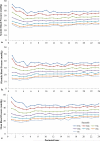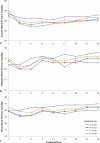Evolving blood pressure dynamics for extremely preterm infants
- PMID: 24503912
- PMCID: PMC3982788
- DOI: 10.1038/jp.2014.6
Evolving blood pressure dynamics for extremely preterm infants
Abstract
Objective: To examine changes in arterial blood pressure (ABP) after birth in extremely preterm infants.
Study design: Prospective observational study of infants 23(0/7) to 26(6/7) weeks gestational age (GA). Antihypotensive therapy use and ABP measurements were recorded for the first 24 h.
Result: A cohort of 367 infants had 18 709 ABP measurements recorded. ABP decreased for the first 3 h, reached a nadir at 4 to 5 h and then increased at an average rate of 0.2 mm Hg h(-1). The rise in ABP from hour 4 to 24 was similar for untreated infants (n=164) and infants given any antihypotensive therapy (n=203), a fluid bolus (n=135) or dopamine (n=92). GA-specific trends were similar. ABP tended to be lower as GA decreased, but varied widely at each GA.
Conclusion: ABP increased spontaneously over the first 24 postnatal hours for extremely preterm infants. The rate of rise in ABP did not change with antihypotensive therapy.
Figures


References
-
- Fanaroff J, Wilson-Costello D, Newman N, Montpetite M, Fanaroff A. Symptomatic hypotension is associated with neonatal morbidity and hearing loss in extremely low birth weight infants. Pediatrics. 2006;117:1131–1135. - PubMed
-
- Hall R, Oliver T. Aortic blood pressure in infants admitted to a neonatal intensive care unit. Am J Dis Child. 1971;121:145–147. - PubMed
-
- Versmold H, Kitterman J, Phibbs R, Gregory G, Tooley W. Aortic blood pressure during the first 12 hours of life in infants with birth weight 610 to 4,220 grams. Pediatrics. 1981;67:607–613. - PubMed
-
- Watkins A, West C, Cooke R. Blood pressure and cerebral haemorrhage and ischaemia in very low birthweight infants. Early Hum Dev. 1989;19:103–110. - PubMed
Publication types
MeSH terms
Grants and funding
- U10 HD021385/HD/NICHD NIH HHS/United States
- UL1 RR025764/RR/NCRR NIH HHS/United States
- U10 HD053124/HD/NICHD NIH HHS/United States
- U10 HD053119/HD/NICHD NIH HHS/United States
- U10 HD021364/HD/NICHD NIH HHS/United States
- UG1 HD087229/HD/NICHD NIH HHS/United States
- UG1 HD053089/HD/NICHD NIH HHS/United States
- U10 HD27871/HD/NICHD NIH HHS/United States
- U10 HD027871/HD/NICHD NIH HHS/United States
- U10 HD027851/HD/NICHD NIH HHS/United States
- UG1 HD040492/HD/NICHD NIH HHS/United States
- UL1 RR025747/RR/NCRR NIH HHS/United States
- UL1 RR025008/RR/NCRR NIH HHS/United States
- UL1 RR24139/RR/NCRR NIH HHS/United States
- U10 HD027856/HD/NICHD NIH HHS/United States
- UL1 RR024139/RR/NCRR NIH HHS/United States
- U10 HD027880/HD/NICHD NIH HHS/United States
- K23 HD068497/HD/NICHD NIH HHS/United States
- U10 HD053109/HD/NICHD NIH HHS/United States
- U10 HD040689/HD/NICHD NIH HHS/United States
- U10 HD040492/HD/NICHD NIH HHS/United States
- U10 HD027853/HD/NICHD NIH HHS/United States
- U10 HD027904/HD/NICHD NIH HHS/United States
- U10 HD034216/HD/NICHD NIH HHS/United States
- U10 HD036790/HD/NICHD NIH HHS/United States
- U10 HD053089/HD/NICHD NIH HHS/United States
- UL1 RR024979/RR/NCRR NIH HHS/United States
LinkOut - more resources
Full Text Sources
Other Literature Sources

